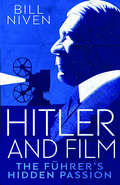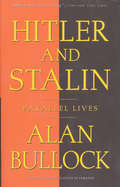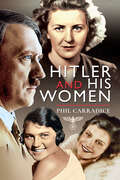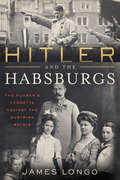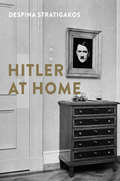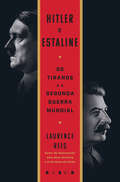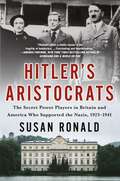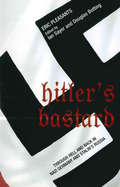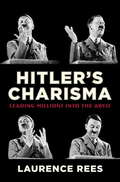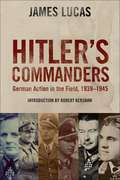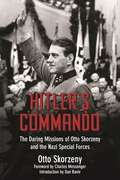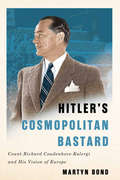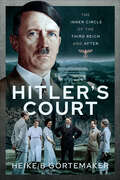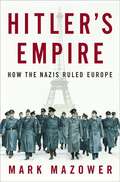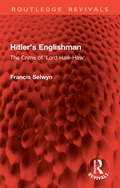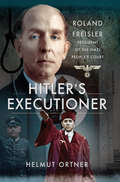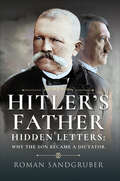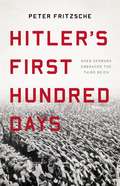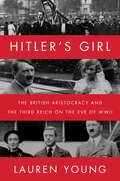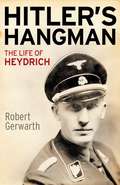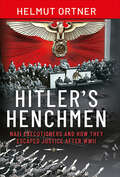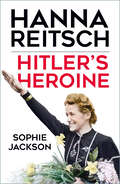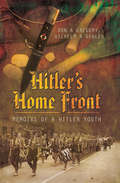- Table View
- List View
Hitler and Film: The Führer's Hidden Passion
by Bill NivenAn exposé of Hitler’s relationship with film and his influence on the film industry A presence in Third Reich cinema, Adolf Hitler also personally financed, ordered, and censored films and newsreels and engaged in complex relationships with their stars and directors. Here, Bill Niven offers a powerful argument for reconsidering Hitler’s fascination with film as a means to further the Nazi agenda. In this first English-language work to fully explore Hitler’s influence on and relationship with film in Nazi Germany, the author calls on a broad array of archival sources. Arguing that Hitler was as central to the Nazi film industry as Goebbels, Niven also explores Hitler’s representation in Third Reich cinema, personally and through films focusing on historical figures with whom he was associated, and how Hitler’s vision for the medium went far beyond “straight propaganda.” He aimed to raise documentary film to a powerful art form rivaling architecture in its ability to reach the masses.
Hitler and Stalin: Parallel Lives
by Alan BullockForty years after his Hitler: A Study in Tyranny set a standard for scholarship of the Nazi era, Lord Alan Bullock gives readers a breathtakingly accomplished dual biography that places Adolf Hitler's origins, personality, career, and legacy alongside those of Joseph Stalin--his implacable antagonist and moral mirror image.
Hitler and his Women
by Phil CarradiceThis unique biography examines Hitler&’s many female relationships, from his mother and sisters to his girlfriends, secretaries, and adoring public. To most of the world, Adolf Hitler was a ranting, evil demagogue whose insane ambitions caused incalculable harm to humanity. But to the women in his life, he was kind, compassionate, and loving—a man to be admired and adored. In Hitler and His Women, historian Phil Carradice explores the Fuhrer&’s many relationships with women, from his romantic involvements to his interactions with female staff and the thousands of women who flocked to hear him speak. While many are familiar with Eva Braun, she was not alone in her role as the Fuhrer&’s lover. Dozens of women preceded her, including Mitzi Reiter, Henny Hoffmann, and his own niece Geli Raubal. To them and many others, Hitler was the ultimate romantic. From deep familial bonds to a teenage infatuation with a girl he never met, from actresses like Zara Leander to English aristocrat Unity Mitford, Carradice examines how Hitlers relationships with women affected the course of history.
Hitler and the Habsburgs: The Führer's Vendetta Against the Austrian Royals
by James Longo&“A detailed and moving picture of how the Habsburgs suffered under the Nazi regime…scrupulously sourced, well-written, and accessible.&”—Publishers Weekly (starred review) It was during five youthful years in Vienna that Adolf Hitler's obsession with the Habsburg Imperial family became the catalyst for his vendetta against a vanished empire, a dead archduke, and his royal orphans. That hatred drove Hitler's rise to power and led directly to the tragedy of the Second World War and the Holocaust. The royal orphans of Archduke Franz Ferdinand—offspring of an upstairs-downstairs marriage that scandalized the tradition-bound Habsburg Empire—came to personify to Adolf Hitler, and others, all that was wrong about modernity, the twentieth century, and the Habsburgs&’ multi-ethnic, multi-cultural Austro-Hungarian Empire. They were outsiders in the greatest family of royal insiders in Europe, which put them on a collision course with Adolf Hitler. As he rose to power Hitler's hatred toward the Habsburgs and their diverse empire fixated on Franz Ferdinand's sons, who became outspoken critics and opponents of the Nazi party and its racist ideology. When Germany seized Austria in 1938, they were the first two Austrians arrested by the Gestapo, deported to Germany, and sent to Dachau. Within hours they went from palace to prison. The women in the family, including the Archduke's only daughter, Princess Sophie Hohenberg, declared their own war on Hitler. Their tenacity and personal courage in the face of betrayal, treachery, torture, and starvation sustained the family during the war and in the traumatic years that followed. Through a decade of research and interviews with the descendants of the Habsburgs, scholar James Longo explores the roots of Hitler's determination to destroy the family of the dead Archduke—and uncovers the family members' courageous fight against the Führer.
Hitler at Home
by Despina StratigakosA look at Adolf Hitler&’s residences and their role in constructing and promoting the dictator&’s private persona both within Germany and abroad. Adolf Hitler&’s makeover from rabble-rouser to statesman coincided with a series of dramatic home renovations he undertook during the mid-1930s. This provocative book exposes the dictator&’s preoccupation with his private persona, which was shaped by the aesthetic and ideological management of his domestic architecture. Hitler&’s bachelor life stirred rumors, and the Nazi regime relied on the dictator&’s three dwellings—the Old Chancellery in Berlin, his apartment in Munich, and the Berghof, his mountain home on the Obersalzberg—to foster the myth of the Führer as a morally upstanding and refined man. Author Despina Stratigakos also reveals the previously untold story of Hitler&’s interior designer, Gerdy Troost, through newly discovered archival sources. At the height of the Third Reich, media outlets around the world showcased Hitler&’s homes to audiences eager for behind-the-scenes stories. After the war, fascination with Hitler&’s domestic life continued as soldiers and journalists searched his dwellings for insights into his psychology. The book&’s rich illustrations, many previously unpublished, offer readers a rare glimpse into the decisions involved in the making of Hitler&’s homes and into the sheer power of the propaganda that influenced how the world saw him.&“Inarguably the powder-keg title of the year.&”—Mitchell Owen, Architectural Digest&“A fascinating read, which reminds us that in Nazi Germany the architectural and the political can never be disentangled. Like his own confected image, Hitler&’s buildings cannot be divorced from their odious political hinterland.&”—Roger Moorhouse, Times
Hitler e Estaline: Os Tiranos e a Segunda Guerra Mundial
by Laurence ReesO conceituado historiador Laurence Rees mergulha nas profundezas dos regimes cruéis de Hitler e Estaline e mostra até que ponto os dois homens brutalizaram o mundo à sua volta. Dois ditadores do século XX distinguem-se pelo impacto e crueldade que tiveram no mundo. Aliados por um curto período de tempo durante a Segunda Guerra Mundial, Hitler e Estaline tentaram depois exterminar-se mutuamente em campanhas de guerra nunca vistas no mundo moderno, afetando soldados e civis de igual modo. Quilómetros sem fim da Europa de Leste foram arruinados neste combate mortal e milhões de vidas foram sacrificadas. Recorrendo a testemunhos inéditos de soldados do Exército Vermelho e da Wehrmacht, de civis que sofreram durante o conflito e daqueles que conheceram pessoalmente os dois homens, esta obra-prima — o culminar de 30 anos de trabalho — do autor bestseller Laurence Rees, um dos melhores historiadores contemporâneos, analisa o percurso dos dois tiranos durante a Segunda Guerra Mundial, quando a Alemanha e a União Soviética travaram a maior e mais sangrenta guerra da História, demonstrando que, apesar de ferozes adversários, Hitler e Estaline eram, em grande medida, os dois lados de uma mesma moeda. «Da autoria de um dos mais conceituados especialistas na Segunda Guerra Mundial, este é um relato importante, original — e devastador — de Hitler e Estaline como ditadores.» Robert Service, autor de Estaline — Uma Biografia «Neste estudo fascinante de dois monstros, Laurence Rees é extraordinariamente percetivo e original.» Sir Antony Beevor, autor de Estalinegrado «Laurence Rees combina de forma brilhante testemunhos poderosos, uma narrativa vívida e uma análise irrefutável neste soberbo relato de como dois terríveis ditadores lideraram os seus países na guerra mais destrutiva e desumana da História.» Sir Ian Kershaw, autor de Hitler «Um trabalho extraordinário e de grande coragem. Revelador, fascinante e extremamente relevante, mostra Hitler e Estaline como nunca foram mostrados. Uma verdadeira história do nosso tempo, com tantas lições a retirar para o mundo conturbado em que vivemos hoje que irá revolucionar o entendimento que temos destes dois tiranos.» Damien Lewis, autor de The Nazi Hunters
Hitler versus Hindenburg
by Larry Eugene JonesHitler versus Hindenburg provides the first in-depth study of the titanic struggle between the two most dominant figures on the German Right in the last year before the establishment of the Third Reich. Although Hindenburg was reelected as Reich president by a comfortable margin, his authority was severely weakened by the fact that the vast majority of those who had supported his candidacy seven years earlier had switched their support to Hitler in 1932. What the two candidates shared in common, however, was that they both relied upon charisma to legitimate their claim to the leadership of the German nation. The increasing reliance upon charisma in the 1932 presidential elections greatly accelerated the delegitimation of the Weimar Republic and set the stage for Hitler's appointment as chancellor nine months later.
Hitler's Aristocrats: The Secret Power Players in Britain and America Who Supported the Nazis, 1923–1941
by Susan RonaldSusan Ronald, acclaimed author of Hitler's Art Thief takes readers into the shadowy world of the aristocrats and business leaders on both sides of the Atlantic who secretly aided Hitler and Nazi Germany.Hitler said, “I am convinced that propaganda is an essential means to achieve one’s aims.” Enlisting Europe’s aristocracy, international industrialists, and the political elite in Britain and America, Hitler spun a treacherous tale everyone wanted to believe: he was a man of peace. Central to his deception was an international high society Black Widow, Princess Stephanie Hohenlohe-Waldenburg-Schillingsfürst, whom Hitler called “his dear princess.” She, and others, conspired for Hitler at the highest levels of the British aristocracy and spread their web to America's wealthy powerbrokers.Hitler’s aristocrats became his eyes, listening posts, and mouthpieces in the drawing rooms, cocktail parties, and weekend retreats of Europe and America. Among these “gentlemen spies” and “ladies of mystery” were the Duke and Duchess of Windsor, Lady Nancy Astor, Charles Lindbergh, and two of the Mitford sisters. They were the trusted voices disseminating his political and cultural propaganda about the “New Germany,” brushing aside the Nazis’ atrocities. Distrustful of his own Foreign Ministry, Hitler used his aristocrats to open the right doors in Great Britain and the United States, creating a formidable fifth column within government and financial circles.In a tale of drama and intrigue, Hitler’s Aristocrats uncovers the battle between these influencers and those who heroically opposed them.
Hitler's Bastard: Through Hell and Back in Nazi Germany and Stalin's Russia
by Eric PleasantsOf all the extraordinary individual accounts that have come out of the Second World War and its aftermath, few can compare with that of Eric Pleasants, a member of the 'bastard' British wing of Hitler's SS - the British Free Corps. In this compelling autobiography, Pleasants writes of the bizarre and traumatic years he spent as a prisoner of the twentieth century's most notorious dictators. A life-long pacifist, Pleasants spent the early years of the war on occupied Jersey. He was imprisoned by the Nazis for petty crimes and the years that followed held a whirlwind of unexpected turns. He lived life on the run in occupied Paris, was captured and recruited into the British Free Corps of the Waffen SS, found love with a young German woman, witnessed the bombing of Dresden and attempted to escape from Soviet troops along the sewers of Berlin. When the war ended, Pleasants found himself on the Communist side of the Iron Curtain. By now a strong man in a travelling circus, he was arrested by the KGB on charges of espionage and sentenced to 25 years' slave labour in the notorious camps of Artic Russia. Only with Stalin's death in 1953 was Pleasants finally released from his unique kind of purgatory, after nearly half a lifetime of peripatetic nightmare. He died in 1998 at the age of 87. Hitler's Bastard remains a remarkable testimony to his imperishable will to survive.
Hitler's Charisma: Leading Millions into the Abyss
by Laurence ReesFuelled by hate, incapable of forming normal human relationships, unwilling to listen to dissenting voices, Adolf Hitler seemed an unlikely leader, and yet he commanded enormous support and was able to exert a powerful influence over those who encountered him. How did Hitler become such an attractive figure to millions of people? That is the question at the core of Hitler's Charisma. Acclaimed historian and documentary filmmaker Laurence Rees examines the nature of Hitler's appeal and reveals the role his supposed "charisma" played in his success. Here is a fascinating social, psychological and historical investigation into the formation of a personality whose determination and vision would at the outset convince a small group of like-minded political and social outcasts but would eventually win over an entire nation and plunge the rest of the world into a cataclysm unlike any that had ever been seen before. Hitler's Charisma is a natural culmination of twenty years of writing and research on the Third Reich and a remarkable examination of the man and the mind at the heart of it all.(With 16 pages of black-and-white illustrations)
Hitler's Commanders: German Action in the Field, 1939–1945
by James LucasAs absolute as Hitler's control over the German war machine was, it depended on the ability, judgment and unquestioning loyalty of the senior officers charged with putting his ideas, however difficult, into effect.Top military historian James Lucas examines the stories of fourteen of these men: all of different rank, from varied backgrounds, and highly awarded, they exemplify German military prowess at its most dangerous. Among his subjects are Eduard Dietl, the commander of German forces in Norway and Eastern Europe; Werner Kampf, one of the most successful Panzer commanders of the war; and Kurt Meyer, commander of the Hitler Youth Division and one of Germany's youngest general officers.The author, one of the leading experts on all aspects of German military conduct of the Second World War, offers the reader a rare look into the nature of the German Army a curious mix of individual strength, petty officialdom and pragmatic action.
Hitler's Commando: The Daring Missions of Otto Skorzeny and the Nazi Special Forces
by Charles Messenger Otto Skorzeny Dan RavivHe was one of the smartest, toughest, most courageous soldiers to fight in World War II. A hero to all who knew him. And he was a Nazi . . . Otto Skorzeny was Germany’s top commando in the Second World War—and one of the most famous men in the history of special forces. His extraordinary wartime career was one of high risk and adventure that few will ever equal. When Mussolini was imprisoned in Italy in 1943, it was Skorzeny who successfully led the daring glider rescue, winning the Knight’s Cross and receiving a promotion as a result. He took a critical role in the Ardennes offensive with a controversial plan to raise a brigade disguised as Americans with captured Sherman tanks. And when his captured countrymen spread a false rumor that he was planning to assassinate Eisenhower, the Allied leader was confined to his headquarters under guard for protection. Dubbed “the most dangerous man in Europe” by the Allies, he was awarded the German Cross in Gold. Here, Skorzeny tells the full story of his exploits in the gripping true story of “a brave and resourceful man who served an evil cause” (New York Journal of Books).
Hitler's Cosmopolitan Bastard: Count Richard Coudenhove-Kalergi and His Vision of Europe
by Martyn BondIn the turbulent period following the First World War the young Count Richard Coudenhove-Kalergi founded the Pan-European Union, offering a vision of peaceful, democratic unity for Europe, with no borders, a common currency, and a single passport. His political congresses in Vienna, Berlin, and Basel attracted thousands from the intelligentsia and the cultural elite, including Albert Einstein, Thomas Mann, and Sigmund Freud, who wanted a United States of Europe brought together by consent. The Count's commitment to this cooperative ideal infuriated Adolf Hitler, who referred to him as a "cosmopolitan bastard" in Mein Kampf.Communists and nationalists, xenophobes and populists alike hated the Count and his political mission. When the Nazis annexed Austria, the Count and his wife, the famous actress Ida Roland, narrowly escaped the Gestapo. He fled to the United States, where he helped shape American policy for postwar Europe. Coudenhove-Kalergi's profile was such that he served as the basis for the fictional resistance hero Victor Laszlo in the film Casablanca.A brilliant networker, the Count guided many European leaders, notably advising Winston Churchill before his 1946 Zürich speech on Europe. A friend to both Chancellor Konrad Adenauer and President Charles de Gaulle, Coudenhove-Kalergi was personally invited to the High Mass in Rheims Cathedral in 1961 to celebrate Franco-German reconciliation. A provocative visionary for Europe, Coudenhove-Kalergi thought and acted in terms of continents, not countries.For the Count, the United States of Europe was the answer to the challenges of communist Russia and capitalist America. Indeed, he launched his Pan-European Union thirty years before Jean Monnet set up the European Coal and Steel Community, the precursor to the European Union. Timely and capitivating, Martyn Bond's biography offers an opportunity to explore a remarkable life and revisit the impetus and origins of a unified Europe.
Hitler's Court: The Inner Circle of The Third Reich and After
by Heike B. GörtemakerThis revelatory history examines the loyal inner circle that followed—and enabled—Hitler’s rise to power and continued on after WWII.Hitler was not a lonely, aloof dictator. Throughout his rise in the NSDAP, he gathered a loyal circle around him, and was surrounded by people who celebrated, flattered and intrigued him. Who belonged to this inner circle around Hitler? What function did this court fulfill? And how did it influence the perception of history after 1945? Using previously unknown sources, Heike Görtemaker explores Hitler’s private environment and shows how this inner circle made him who he was. Hitler’s inner circle, the Berghof Society, was his private retreat. But the court was more than that. It provided him with the support he needed to take on the role of “Führer” at all, while at the same time allowing him to use its members as political front men. Most of all, it represented a conspiratorial community whose lowest common denominator was anti-Semitism. In this book, Heike Görtemaker asks new questions about the truth behind Hitler’s inner circle and, for the first time, also examines the “circle without leaders”; the networking of the inner circle after 1945.
Hitler's Empire: How the Nazis Ruled Europe
by Mark MazowerDrawing on an unprecedented variety of sources, Mark Mazower reveals how the Nazis designed, maintained, and ultimately lost their European empire and offers a chilling vision of the world Hitler would have made had he won the war. Germany's forces achieved, in just a few years, the astounding domination of a landmass and population larger than that of the United States. Control of this vast territory was meant to provide the basis for Germany's rise to unquestioned world power. Eastern Europe was to be the Reich's Wild West, transformed by massacre and colonial settlement. Western Europe was to provide the economic resources that would knit an authoritarian and racially cleansed continent together. But the brutality and short-sightedness of Nazi politics lost what German arms had won and brought their equally rapid downfall. Time and again, the speed of the Germans' victories caught them unprepared for the economic or psychological intricacies of running such a far-flung dominion. Politically impoverished, they had no idea how to rule the millions of people they suddenly controlled, except by bludgeon. Mazower forces us to set aside the timeworn notion that the Nazis' worldview was their own invention. Their desire for land and their racist attitudes toward Slavs and other nationalities emerged from ideas that had driven their Prussian forebears into Poland and beyond. They also drew inspiration on imperial expansion from the Americans and especially the British, whose empire they idolized. Their signal innovation was to exploit Europe's peoples and resources much as the British or French had done in India and Africa. Crushed and disheartened, many of the peoples they conquered collaborated with them to a degree that we have largely forgotten. Ultimately, the Third Reich would be beaten as much by its own hand as by the enemy. Throughout this book are fascinating, chilling glimpses of the world that might have been. Russians, Poles, and other ethnic groups would have been slaughtered or enslaved. Germans would have been settled upon now empty lands as far east as the Black Sea--the new "Greater Germany. " Europe's treasuries would have been sacked, its great cities impoverished and recast as dormitories for forced laborers when they were not deliberately demolished. As dire as all this sounds, it was merely the planned extension of what actually happened in Europe under Nazi rule as recounted in this authoritative, absorbing book.
Hitler's Englishman: The Crime of 'Lord Haw-Haw' (Routledge Revivals)
by Francis Selwyn‘Lord Haw-Haw’ (William Joyce) was Hitler’s secret weapon of the airwaves. Nightly through the Second World War Joyce’s nasal tones were transmitted to a delighted if sceptical audience. He had a large and enthusiastic following, who looked upon his catchphrase ‘Jairmany calling’ as the promise of comic relief as sure as that provided by Tommy Handley and the much-loved radio programme It’s That Man Again (ITMA).Joyce, of course, was not a figure of fun; nor was he regarded as one by the British government which twisted and adjusted the law to bring him to a traitor’s death in 1946. Originally published in 1987, in this new approach to the case of William Joyce, Francis Selwyn looks both at the career of Joyce, the Irish-American-cum-Fascist bully-boy, and the changing nature of treason, altered by the events of the Second World War.Was Joyce a traitor? Or was he sent to the scaffold as a necessary sacrifice? Behind the voice of the decadent aristocrat lurked the real William Joyce, a street-corner fanatic of the Fascist movement. Who was he? Hitler’s Englishman follows the path to Nazi treason and the final reckoning on the gallows of Wandsworth Prison.Treason, as Francis Selwyn shows, is a crime which has been adapted to circumstances. After the Second Word War it was reshaped to embrace ‘new’ traitors, who had committed different kinds of treason. For Joyce, his loyalty to the ideals of Nazism transcended territory and nationality: he had no regrets about what he had done. His story, and the story of treason in the days of victory over Fascism, still have a powerful message for us today.
Hitler's Executioner: Roland Freisler, President of the Nazi People's Court
by Helmut OrtnerThe biography of the infamous judge who oversaw Nazi justice for the Third Reich as president of the &“People&’s Court.&” Though little known, the name of the judge Roland Freisler is inextricably linked to the judiciary in Nazi Germany. As well as serving as the State Secretary of the Reich Ministry of Justice, he was the notorious president of the &“People&’s Court,&” a man directly responsible for more than 2,200 death sentences; with almost no exceptions, cases in the &“People&’s Court&” had predetermined guilty verdicts. It was Freisler, for example, who tried three activists of the White Rose resistance movement in February 1943. He found them guilty of treason and sentenced the trio to death by beheading; a sentence carried out the same day by guillotine. In August 1944, Freisler played a central role in the show trials that followed the failed attempt to assassinate Adolf Hitler on 20 July that year—a plot known more commonly as Operation Valkyrie. Many of the ringleaders were tried by Freisler in the &“People&’s Court.&” Nearly all of those found guilty were sentenced to death by hanging, the sentences being carried out within two hours of the verdicts being passed. Roland Freisler&’s mastery of legal texts and dramatic courtroom verbal dexterity made him the most feared judge in the Third Reich. In this in-depth examination, Helmut Ortner not only investigates the development and judgments of the Nazi tribunal, but the career of Freisler, a man who was killed in February 1945 during an Allied air raid.
Hitler's Executioner: Roland Freisler, President of the Nazi People's Court
by Helmut OrtnerThe biography of the infamous judge who oversaw Nazi justice for the Third Reich as president of the &“People&’s Court.&” Though little known, the name of the judge Roland Freisler is inextricably linked to the judiciary in Nazi Germany. As well as serving as the State Secretary of the Reich Ministry of Justice, he was the notorious president of the &“People&’s Court,&” a man directly responsible for more than 2,200 death sentences; with almost no exceptions, cases in the &“People&’s Court&” had predetermined guilty verdicts. It was Freisler, for example, who tried three activists of the White Rose resistance movement in February 1943. He found them guilty of treason and sentenced the trio to death by beheading; a sentence carried out the same day by guillotine. In August 1944, Freisler played a central role in the show trials that followed the failed attempt to assassinate Adolf Hitler on 20 July that year—a plot known more commonly as Operation Valkyrie. Many of the ringleaders were tried by Freisler in the &“People&’s Court.&” Nearly all of those found guilty were sentenced to death by hanging, the sentences being carried out within two hours of the verdicts being passed. Roland Freisler&’s mastery of legal texts and dramatic courtroom verbal dexterity made him the most feared judge in the Third Reich. In this in-depth examination, Helmut Ortner not only investigates the development and judgments of the Nazi tribunal, but the career of Freisler, a man who was killed in February 1945 during an Allied air raid.
Hitler's Father: Hidden Letters: Why the Son Became a Dictator
by Roman SandgruberThe bundle of 31 letters, the pages of which had long yellowed with age, had lain hidden in the attic where they were found for over a century. Only when the razor-sharp script was examined further did historians discover just who had written them – and that person, Alois, was Adolf Hitler’s father. Born Alois Schicklgruber on 7 June 1837, the identity of his biological father still undisclosed, Alois eventually became a civil servant in the Austrian customs service. At around the age of 40, Alois changed his family name from Schicklgruber to Hitler – his infamous son being born some eleven years later. The contents of the re-discovered letters have allowed the renowned historian and author Roman Sandgruber to reassess the image that we have of Alois, offering the world a completely new and authentic impression of the man. In Hitler’s Father, Sandgruber re-examines Alois’ personality and how he significantly shaped the young Adolf. The letters also shed further light onto the everyday life of the Hitler family as whole, a story which is often characterized by myths, inventions and assumptions. They have given the author the opportunity to recount the childhood and youth of the future dictator, painting a dramatic picture of the ‘Führer’ growing up. These letters also help answer the question that is so often asked: How could a child from an Upper Austrian province, seemingly a failure and self-taught, rise to a position of such power? Indeed, Adolf Hitler’s father and ‘the province’ seemingly lay heavily on him until his suicide in the Führerbunker in 1945. The author examines how the young Hitler’s lowly upbringing may have affected him in the years that followed – years which shaped the history of the whole world.
Hitler's First Hundred Days: When Germans Embraced the Third Reich
by Peter FritzscheThis unsettling and illuminating history reveals how Germany's fractured republic gave way to the Third Reich, from the formation of the Nazi party to the rise of Hitler.Amid the ravages of economic depression, Germans in the early 1930s were pulled to political extremes both left and right. Then, in the spring of 1933, Germany turned itself inside out, from a deeply divided republic into a one-party dictatorship. In Hitler's First Hundred Days, award-winning historian Peter Fritzsche offers a probing account of the pivotal moments when the majority of Germans seemed, all at once, to join the Nazis to construct the Third Reich. Fritzsche examines the events of the period -- the elections and mass arrests, the bonfires and gunfire, the patriotic rallies and anti-Jewish boycotts -- to understand both the terrifying power the National Socialists exerted over ordinary Germans and the powerful appeal of the new era they promised.Hitler's First Hundred Days is the chilling story of the beginning of the end, when one hundred days inaugurated a new thousand-year Reich.
Hitler's Girl: The British Aristocracy and the Third Reich on the Eve of WWII
by Lauren YoungA timely, riveting book that presents for the first time an alternative history of 1930s Britain, revealing how prominent fascist sympathizers nearly succeeded in overturning British democracy—using the past as a road map to navigate the complexities of today’s turn toward authoritarianism.Hitler’s Girl is a groundbreaking history that reveals how, in the 1930s, authoritarianism nearly took hold in Great Britain as it did in Italy and Germany. Drawing on recently declassified intelligence files, Lauren Young details the pervasiveness of Nazi sympathies among the British aristocracy, as significant factions of the upper class methodically pursued an actively pro-German agenda. She reveals how these aristocrats formed a murky Fifth Column to Nazi Germany, which depended on the complacence and complicity of the English to topple its proud and long-standing democratic tradition—and very nearly succeeded.As she highlights the parallels to our similarly treacherous time, Young exposes the involvement of secret organizations like the Right Club, which counted the Duke of Wellington among its influential members; the Cliveden Set, which ran a shadow foreign policy in support of Hitler; and the shocking four-year affair between socialite Unity Mitford and Adolf Hitler.Eye-opening and instructive, Hitler’s Girl re-evaluates 1930s England to help us understand our own vulnerabilities and poses urgent questions we must face to protect our freedom. At what point does complacency become complicity, posing real risk to the democratic norms that we take for granted? Will democracy again succeed—and will it require a similarly cataclysmic event like World War II to ensure its survival? Will we, in our own defining moment, stand up for democratic values—or will we succumb to political extremism?
Hitler's Hangman: The Life of Heydrich
by Robert GerwarthA chilling biography of the head of Nazi Germany&’s terror apparatus, a key player in the Third Reich whose full story has never before been told. Reinhard Heydrich is widely recognized as one of the great iconic villains of the twentieth century, an appalling figure even within the context of the Nazi leadership. Chief of the Nazi Criminal Police, the SS Security Service, and the Gestapo, ruthless overlord of Nazi-occupied Bohemia and Moravia, and leading planner of the "Final Solution," Heydrich played a central role in Hitler's Germany. He shouldered a major share of responsibility for some of the worst Nazi atrocities, and up to his assassination in Prague in 1942, he was widely seen as one of the most dangerous men in Nazi Germany. Yet Heydrich has received remarkably modest attention in the extensive literature of the Third Reich. Robert Gerwarth weaves together little-known stories of Heydrich's private life with his deeds as head of the Nazi Reich Security Main Office. Fully exploring Heydrich's progression from a privileged middle-class youth to a rapacious mass murderer, Gerwarth sheds new light on the complexity of Heydrich's adult character, his motivations, the incremental steps that led to unimaginable atrocities, and the consequences of his murderous efforts toward re-creating the entire ethnic makeup of Europe. &“This admirable biography makes plausible what actually happened and makes human what we might prefer to dismiss as monstrous.&”—Timothy Snyder, Wall Street Journal &“[A] probing biography…. Gerwarth&’s fine study shows in chilling detail how genocide emerged from the practicalities of implementing a demented belief system.&”—Publishers Weekly &“A thoroughly documented, scholarly, and eminently readable account of this mass murderer.&”—The New Republic
Hitler's Henchmen: Nazi Executioners and How They Escaped Justice After WWII
by Helmut OrtnerHelmut Ortner reveals a staggering history of perpetrators, victims and bystanders in Hitler’s Germany. He explores the shocking evidence of a merciless era – and of the shameful omissions of post-war German justice. Johann Reichhart was a state-appointed judicial executioner in Bavaria from 1924 until the end of the war in Europe. During the Nazi era, he executed numerous people who were sentenced to death for resisting National Socialism, including many of those involved in the 20 July 1944 bomb plot on Adolf Hitler. As a member of the SS-Totenkopfverbände, the SS organisation responsible for administering the concentration and extermination camps, Arnold Strippel served at a number of locations during his rise to the rank of SS-Obersturmführer. These included Natzweiler-Struthof, Buchenwald, Majdanek, Ravensbrück and Neuengamme, where he was responsible for murdering the victims of a series of tuberculosis medical experiments. Like Reichhart, Erich Schwinge was also involved in the legal sphere during the Third Reich. A German military lawyer, in 1931 he became a professor of law and, from 1936, wrote the legal commentary on German military criminal law that was decisive during the Nazi era. Aside from the part they played in Hitler’s regime, these three men all had one further thing in common – they survived the war and restarted their careers in Adenauer’s Federal Republic of Germany. In Hitler’s Henchmen, Helmut Ortner uncovers the full stories of Reichhart, Strippel, Schwinge and others like them, Nazi perpetrators who enjoyed post-war careers as judges, university professors, doctors and politicians. Had they been gutless cogs in the machinery of the Nazi state, or ideologized persecutors? Ortner reveals that it was not only their Nazi pasts that were forgotten, but how the suffering of the victims, including resistance fighters such as Georg Elser and Maurice Becaud, and their relatives was suppressed and ignored.
Hitler's Heroine: Hanna Reitsch
by Sophie JacksonHanna Reitsch longed to fly. Having broken records and earned the respect of the Nazi regime, she was the first female Luftwaffe test pilot, and eventually became Adolf Hitler’s personal heroine.An ardent Nazi, Hanna was prepared to die for the cause, first as a test pilot for the dangerous V1 flying bombs and later by volunteering for a suggested Nazi ‘kamikaze’ squadron. After her capture she complained bitterly of not being able to die with her leader, but she went on to have a celebrated post-war flying career. She died at the age of 67, creating a new mystery – did Hanna kill herself using the cyanide pill Hitler had given her over thirty years earlier? Hitler’s Heroine reveals new facts about the mysterious pilot and cuts through the many myths that have surrounded her life and death, bringing this fascinating woman back to life for the twenty-first century.
Hitler's Home Front: Memoirs of a Hitler Youth
by Don A Gregory Wilhelm R GehlenA &“candid and revealing memoir shows a normal boy and a family at war and in its aftermath, determined to do what it took to survive . . . fascinating&” (The Great War). When Adolf Hitler and the Nazi Party came into power in 1933, he promised the downtrodden, demoralized, and economically broken people of Germany a new beginning and a strong future. Millions flocked to his message, including a corps of young people called the Hitlerjugend—the Hitler Youth. By 1942 Hitler had transformed Germany into a juggernaut of war that swept over Europe and threatened to conquer the world. It was in that year that a nine-year-old Wilhelm Reinhard Gehlen, took the &‘Jungvolk&’ oath, vowing to give his life for Hitler. This is the story of Wilhelm Gehlen&’s childhood in Nazi Germany during World War II and the awful circumstances which he and his friends and family had to endure during and following the war. Including a handful of recipes and descriptions of the strange and sometimes disgusting food that nevertheless kept people alive, this book sheds light on the truly awful conditions and the twisted, mistaken devotion held by members of the Hitler Youth—that it was their duty to do everything possible to save the Thousand Year Reich.
